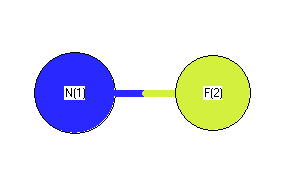Jump to
S2C1
Energy calculated at LSDA/STO-3G
| | hartrees |
|---|
| Energy at 0K | -151.530860 |
| Energy at 298.15K | -151.530865 |
| Nuclear repulsion energy | 24.574156 |
The energy at 298.15K was derived from the energy at 0K
and an integrated heat capacity that used the calculated vibrational frequencies.
Geometric Data calculated at LSDA/STO-3G
Point Group is C∞v
Cartesians (Å)
| Atom |
x (Å) |
y (Å) |
z (Å) |
|---|
| N1 |
0.000 |
0.000 |
-0.763 |
| F2 |
0.000 |
0.000 |
0.594 |
Atom - Atom Distances (Å)
 More geometry information
More geometry information
Electronic energy levels
Charges, Dipole, Quadrupole and Polarizability
Charges from optimized geometry at LSDA/STO-3G
Charges (e)
| Number |
Element |
Mulliken |
CHELPG |
AIM |
ESP |
| 1 |
N |
-0.055 |
|
|
|
| 2 |
F |
0.055 |
|
|
|
Electric dipole moments
Electric dipole components in Debye
(What's a Debye? See section
VII.A.3)
| |
x |
y |
z |
Total |
| |
0.000 |
0.000 |
0.858 |
0.858 |
| CHELPG |
|
|
|
|
| AIM |
|
|
|
|
| ESP |
|
|
|
|
Electric Quadrupole moment
Quadrupole components in D Å
| Primitive |
|---|
| | x | y | z |
|---|
| x |
-8.592 |
0.000 |
0.000 |
| y |
0.000 |
-8.592 |
0.000 |
| z |
0.000 |
0.000 |
-9.547 |
|
| Traceless |
|---|
| | x | y | z |
|---|
| x |
0.478 |
0.000 |
0.000 |
| y |
0.000 |
0.478 |
0.000 |
| z |
0.000 |
0.000 |
-0.955 |
|
| Polar |
|---|
| 3z2-r2 | -1.911 |
|---|
| x2-y2 | 0.000 |
|---|
| xy | 0.000 |
|---|
| xz | 0.000 |
|---|
| yz | 0.000 |
|---|
|
Polarizabilities
Components of the polarizability tensor.
Units are
Å
3 (Angstrom cubed)
Change units.
| |
x |
y |
z |
| x |
0.274 |
0.000 |
0.000 |
| y |
0.000 |
0.274 |
0.000 |
| z |
0.000 |
0.000 |
1.016 |
<r2> (average value of r
2) Å
2
| <r2> |
0.000 |
| (<r2>)1/2 |
0.000 |
Jump to
S1C1
Energy calculated at LSDA/STO-3G
| | hartrees |
|---|
| Energy at 0K | -151.453526 |
| Energy at 298.15K | -151.453533 |
| Nuclear repulsion energy | 24.638197 |
The energy at 298.15K was derived from the energy at 0K
and an integrated heat capacity that used the calculated vibrational frequencies.
Geometric Data calculated at LSDA/STO-3G
Point Group is C∞v
Cartesians (Å)
| Atom |
x (Å) |
y (Å) |
z (Å) |
|---|
| N1 |
0.000 |
0.000 |
-0.761 |
| F2 |
0.000 |
0.000 |
0.592 |
Atom - Atom Distances (Å)
 More geometry information
More geometry information
Electronic energy levels
Charges, Dipole, Quadrupole and Polarizability
Charges from optimized geometry at LSDA/STO-3G
Charges (e)
| Number |
Element |
Mulliken |
CHELPG |
AIM |
ESP |
| 1 |
N |
-0.087 |
|
|
|
| 2 |
F |
0.087 |
|
|
|
Electric dipole moments
Electric dipole components in Debye
(What's a Debye? See section
VII.A.3)
| |
x |
y |
z |
Total |
| |
0.000 |
0.000 |
1.064 |
1.064 |
| CHELPG |
|
|
|
|
| AIM |
|
|
|
|
| ESP |
|
|
|
|
Electric Quadrupole moment
Quadrupole components in D Å
| Primitive |
|---|
| | x | y | z |
|---|
| x |
-7.677 |
0.000 |
0.000 |
| y |
0.000 |
-9.558 |
0.000 |
| z |
0.000 |
0.000 |
-9.546 |
|
| Traceless |
|---|
| | x | y | z |
|---|
| x |
1.874 |
0.000 |
0.000 |
| y |
0.000 |
-0.946 |
0.000 |
| z |
0.000 |
0.000 |
-0.928 |
|
| Polar |
|---|
| 3z2-r2 | -1.856 |
|---|
| x2-y2 | 1.881 |
|---|
| xy | 0.000 |
|---|
| xz | 0.000 |
|---|
| yz | 0.000 |
|---|
|
Polarizabilities
Components of the polarizability tensor.
Units are
Å
3 (Angstrom cubed)
Change units.
| |
x |
y |
z |
| x |
0.386 |
0.000 |
0.000 |
| y |
0.000 |
0.041 |
0.000 |
| z |
0.000 |
0.000 |
1.004 |
<r2> (average value of r
2) Å
2
| <r2> |
12.785 |
| (<r2>)1/2 |
3.576 |
